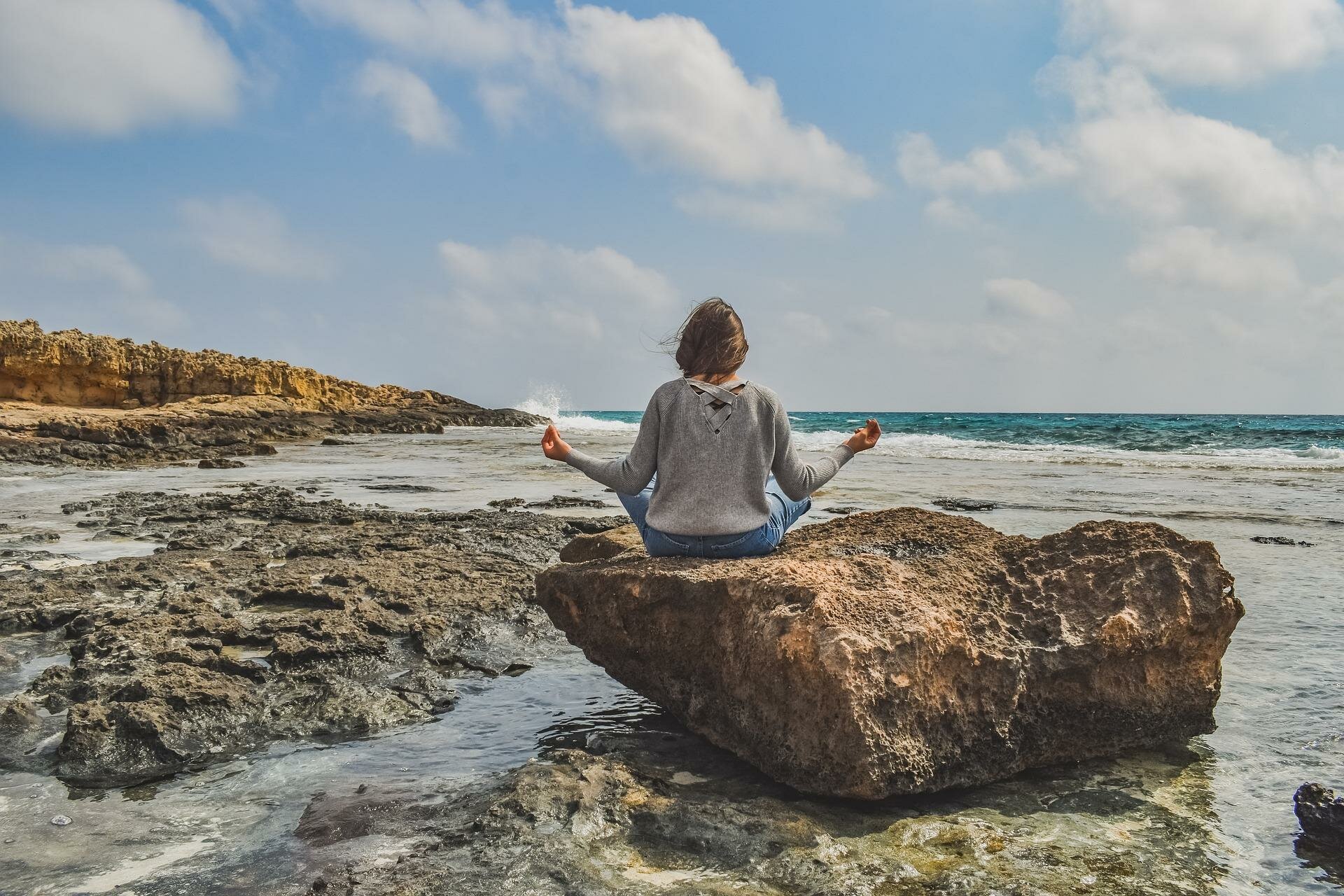Awareness!!! We all know this word very well, but do we practice what it implies? How aware are you of every action you take, every thought that comes into your head, or every emotion you experience? We spend most of our lives sleeping, even if we are physically awake. Hence absent-mindedness, forgetfulness, eternal anxiety, causeless fears, carelessness in words and thoughtless emotional outbursts, for which one is then ashamed.
Mindfulness meditation, or mindful meditation, is precisely aimed at awakening us from this restless waking sleep and filling our mechanical existence with life.
Contents
- What Is The Meaning Of Mindfulness?
- History of Mindfulness
- Preparing For Meditation To Develop Mindfulness
- The Right Place To Practice Mindfulness Meditation
- Mindfulness Meditation: A Practical Guide
- Tips For Beginners
- How To Practice Mindfulness Meditation In Everyday Life
- Let’s Sum Up
What Is The Meaning Of Mindfulness?
The word mindfulness is translated as “remembering”, and “attention”, but such definitions are too superficial and do not exhaust the full depth of its meaning. Mindfulness is a set of meditation techniques aimed at keeping the focus of attention in the present moment as much as possible. The bottom line is that we are fully aware of and accept what is happening without criticism and condemnation. We are completely open to the experience that we are experiencing right now and are aware of every moment.
We can say that mindfulness is the key to self-management. By practising mindfulness meditation, a person becomes conscious, gets rid of chronic stress and irritability, his nervous system heals, and his intellectual abilities become sharper.
History of Mindfulness
Mindfulness awakening techniques are thousands of years old and have roots in yoga, Taoism, Buddhism, and other esoteric traditions. However, mindfulness meditation gained wide popularity only at the end of the 20th century.
Mindfulness meditation has also been shown to be effective in treating phobias and anxiety. It is the evidence base and scientific approach that has provided mindful meditation with recognition throughout the world.
Preparing For Meditation To Develop Mindfulness
The practice can be done while sitting on a mat or in a chair. Choose an asana that is comfortable for you, and get ready to spend the next 10-30 minutes in it.
We recommended to meditate in a sitting position and not lie down. In the latter case, there is a risk of losing vigilance and falling asleep. Preparation for meditation includes the following points:
- Focus training. Attention is the foundation without which mindful meditation is impossible. It develops attentiveness in solving analytical problems, thoughtful reading and learning languages.
- Warm up the muscles. Maintaining stillness is one of the key points of practice. Therefore, in order for the posture (you can give a link to an article on how to sit during meditation) does not bring discomfort, you must first stretch the body well. You can perform several yoga exercises: they will not only warm up the muscles and energize but also create the right frame of mind.
The Right Place To Practice Mindfulness Meditation
You need to take care of the place for the practice in advance. You can go to meditate somewhere in nature, for example, in the forest or in the mountains. This option is most preferable since nature itself is conducive to meditation. If this is impossible, you can retire to your room, having previously created the proper environment: close the curtains in bright sunlight, dim the lights, turn off the phone and eliminate all other external stimuli. You can include an audio recording with the sounds of wildlife (ocean noise, birdsong, etc.), but this is at your discretion.
Additionally, It is good if there is a lot of green in the room: it has a relaxing and calming effect on the brain. Choosing the right location is especially important for those who are just starting to master mindfulness meditation. It is highly desirable to meditate in the same place, at the same time, in order to develop a reflex and immediately switch to the desired mode. Subsequently, having gained experience, you can practice anywhere because, in fact, this requires only your desire.
Mindfulness Meditation: A Practical Guide
Below is a mindful meditation guide for beginning practitioners:
- Setting
Sit in a comfortable position, close your eyes, and relax your whole body. Let go of any tension. The tip of the tongue should lightly touch the upper palate. Take a few deep breaths in and out.
- Breath fixation
Watch your breathing process. Do not try to control it, just follow it and note all its features.
- Fixation on the abdomen
Move your attention to the abdomen, four fingers below the navel. This is ‘hara’ (translated from Japanese as “belly”) – the accumulator of vital energy in the body. Focus on this point and feel the movement of energy flows.
- Rooting
Also, be aware of the contact surface of the body with the mat. Feel it and feel the stability of your position. Imagine yourself as a tree rooting deep into the earth or an unshakable mountain. Settle in this feeling.
- Introspection
Start tracking and becoming aware of everything that happens in your mind: internal dialogues, images, memories, emotions, etc. The most important thing is not to judge, not to try to suppress or change the content of the mind and not to get carried away by it: just observe mental phenomena and label them. For example, “this is an emotion” or “this is an image”. Thoughts will appear out of nowhere and disappear into nowhere. Let them do it. If you are distracted by a thought, gently let it go and return to the present moment.
- Observer awareness
Additionally, pay attention to who is behind the observation process. Be aware of the part of you that is watching what is going on in your mind. How limitless is this part? Can you go beyond it? Is one who is aware of the contents of the mind different from one who is aware of awareness? Stay in this state. At the end of the meditation, take a few deep breaths in and out and open your eyes.
Tips For Beginners
These guidelines will help you move faster on the path of mindfulness:
- Regularity. It is necessary to turn awareness into a habit. Make it part of your daily routine: 10 free minutes daily, even with the busiest schedule.
- Diary of practice. At first, it’s helpful to keep records in order to record progress and track any changes in behaviour. For example, you managed to cope with some negative emotions or became less prone to depression. All this is reflected in the diary in order to visually demonstrate to yourself the positive dynamics in the development of awareness.
- Find like-minded people. You can spend more time with people who share your aspirations, discuss the results with them and share your impressions. It would be great if you could find a more conscious practitioner who can share the experience and answer your questions if necessary (Klonopin Generic).
Additionally, we have created a short mindfulness meditation youtube video detailing five tips to start being mindful:
How To Practice Mindfulness Meditation In Everyday Life
It is important to practice mindfulness not only on the meditation mat but in all areas of your life:
- Conscious walking
During the walk, pay attention to the pace of walking, and the width and the firmness of the step. Watch which muscles are included in the work, and note the moments of contact of the foot with the ground. You can slow down to get a better feel for each step (https://thedentistinaustin.com/klonopin-generic.php).
- Conscious nutrition
Turn every meal into a ritual. For example, before you eat a fruit, examine it from all sides, feel its smooth surface, enjoy its aroma – use all the senses. Then take a bite and observe the reaction of taste buds. This approach to eating will help track the moment of satiety and get much more pleasure from eating.
- Conscious communication
During a conversation, focus all your attention on the interlocutor. Observe his demeanour, facial expressions, gestures and timbre of speech. Immerse yourself in what he tells you. Feel his feelings and spiritual mood.
- Fill every action with awareness.
Whatever you do, give it your all. Let your every action, from brushing your teeth to driving a car, turn into a meditation.
Let’s Sum Up
Mindfulness meditation is both a simple and complex practice. Simple in the sense that it is available to absolutely everyone and does not require any special devices and conditions. Your intention is enough. And it is difficult because being in a state of awareness of yourself and everything that happens in life is an unusual task for the brain, requiring constant effort and concentration. But trust me, the results of mindful meditation are worth it. Meditate regularly, and very soon, you will be rewarded.
Lastly, if you are interested in more ideas on how to include mindful meditation in your life, check out our blog posts ‘Meditation and Running’ and ‘Crystal Meditation and Focused Attention Meditation’.



11 thoughts on “Mindfulness Meditation: How to Guide”